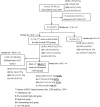Evaluation of abdominal ultrasonography mass screening for hepatocellular carcinoma in Taiwan
- PMID: 24002724
- PMCID: PMC4296217
- DOI: 10.1002/hep.26703
Evaluation of abdominal ultrasonography mass screening for hepatocellular carcinoma in Taiwan
Abstract
Mass screening with abdominal ultrasonography (AUS) has been suggested as a tool to control adult hepatocellular carcinoma (HCC) in individuals, but its efficacy in reducing HCC mortality has never been demonstrated. This study aimed to assess the effectiveness of reducing HCC mortality by mass AUS screening for HCC based on a program designed and implemented in the Changhua Community-based Integrated Screening (CHCIS) program with an efficient invitation scheme guided by the risk score. We invited 11,114 (27.0%) of 41,219 eligible Taiwanese subjects between 45 and 69 years of age who resided in an HCC high-incidence area to attend a risk score-guided mass AUS screening between 2008 and 2010. The efficacy of reducing HCC mortality was estimated. Of the 8,962 AUS screening attendees (with an 80.6% attendance rate), a total of 16 confirmed HCC cases were identified through community-based ultrasonography screening. Among the 16 screen-detected HCC cases, only two died from HCC, indicating a favorable survival. The cumulative mortality due to HCC (per 100,000) was considerably lower in the invited AUS group (17.26) compared with the uninvited AUS group (42.87) and the historical control group (47.51), yielding age- and gender-adjusted relative mortality rates of 0.69 (95% confidence interval [CI]: 0.56-0.84) and 0.63 (95% CI: 0.52-0.77), respectively.
Conclusion: The residents invited to community-based AUS screening for HCC, compared with those who were not invited, showed a reduction in HCC mortality by ∼ 31% among subjects aged 45-69 years who had not been included in the nationwide vaccination program against hepatitis B virus infection.
Copyright © 2014 The Authors. HEPATOLOGY published by Wiley on behalf of the American Association for the Study of Liver Diseases.
Figures




Comment in
-
Screening for liver cancer: another piece of the puzzle?Hepatology. 2014 May;59(5):1673-5. doi: 10.1002/hep.26936. Epub 2014 Apr 1. Hepatology. 2014. PMID: 24254319 No abstract available.
-
Reply: To PMID 24002724.Hepatology. 2015 Mar;61(3):1092-3. doi: 10.1002/hep.27308. Epub 2015 Jan 20. Hepatology. 2015. PMID: 25042409 No abstract available.
-
Should hepatocellular carcinoma screening with ultrasound be recommended in hepatocellular carcinoma high-incidence areas?Hepatology. 2015 Mar;61(3):1091-2. doi: 10.1002/hep.27300. Epub 2015 Jan 20. Hepatology. 2015. PMID: 25044031 No abstract available.
References
-
- Chang MH, Chen CJ, Lai MS, Hsu HM, Wu TC, Kong MS. Universal hepatitis B vaccination in Taiwan and the incidence of hepatocellular carcinoma in children. Taiwan Childhood Hepatoma Study Group. N Engl J Med. 1997;336:1855–1859. , et al. - PubMed
-
- Tseng PL, Wang JH, Tung HD, Hung CH, Kee KM, Chen CH. Optimal treatment increased survival of hepatocellular carcinoma patients detected with community-based screening. J Gastroenterol Hepatol. 2010;25:1426–1434. , et al. - PubMed
-
- Chen TH, Chen CJ, Yen MF, Lu SN, Sun CA, Huang GT. Ultrasound screening and risk factors for death from hepatocellular carcinoma in a high risk group in Taiwan. Int J Cancer. 2002;98:257–261. , et al. - PubMed
-
- Chen TH, Chiu YH, Luh DL, Yen MF, Wu HM, Chen LS. Taiwan Community-Based Integrated Screening Group. Community-based multiple screening model: design, implementation, and analysis of 42,387 participants. Cancer. 2004;100:1734–1743. , et al. - PubMed
MeSH terms
LinkOut - more resources
Full Text Sources
Other Literature Sources
Medical
